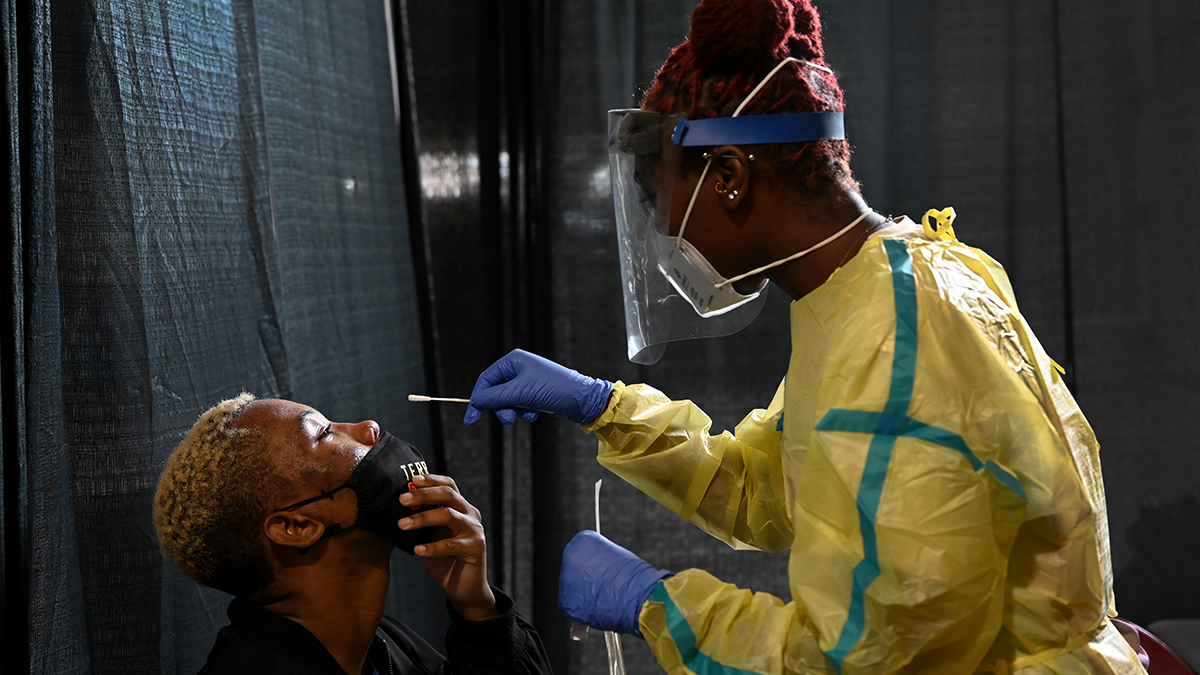Go here for the latest coronavirus news and data on Nov. 19, 2020.
The U.S. has surpassed 250,000 coronavirus deaths as case numbers and hospitalizations reach record-high levels.
In D.C., a 35-year-old man was among five people reported Tuesday to have died from COVID-19.
We're making it easier for you to find stories that matter with our new newsletter — The 4Front. Sign up here and get news that is important for you to your inbox.
The worsening pandemic is pushing more local leaders to address constituents more frequently.
After the District on Tuesday reported the second-highest number of new coronavirus diagnoses in a single day, D.C. Mayor Muriel Bowser addressed the possibility of new restrictions. She said they may be necessary "soon," but wasn't ready to give further details.
On Monday, D.C. will begin asking for health insurance at COVID-19 testing sites, including a new one set to open at Nationals Park. Anyone can get tested for free whether they have insurance or not, but the city hopes to get paid back for testing done on residents who have insurance.
Montgomery County Executive Marc Elrich and Virginia Gov. Ralph Northam addressed the surge at news conferences on Wednesday afternoon.
Coronavirus Cases by Neighborhood in D.C.
Source: D.C. Coronavirus Hub Credit: Anisa Holmes/NBC Washington
Last updated Dec. 9
Virginia has already adopted new restrictions on bars, restaurants and public gatherings.
Maryland Gov. Larry Hogan issued a dire warning on Tuesday: He said the fight against the virus is a war and the virus is winning. He said in response, the state will tighten restrictions.
Starting at 5 p.m. Friday, new restrictions will take effect for bars and restaurants, nursing homes and gyms, retail stores and churches.
Hospitalizations in Maryland are the highest they've been since the summer.
Hundreds students at D.C. public elementary schools were set to return to class today.
Some students at 35 elementary schools were invited to return for in-person learning in small groups with a teacher. Others will be in small groups taught by a teacher working remotely and supervised by a school employee.
Administrators expect more than 600 students in this first phase. All chose to return to school.
The process to enter the building will be different. Social distancing, and face masks are required.
Students will receive breakfast and lunch, which they will eat in their classroom.
D.C. Public Schools has planned to roll out more in-person learning in December.
However, the Washington Teacher’s Union released a statement saying teachers wouldn’t sign an agreement to reopen schools.
The union says it takes issue with a lack of clear public health guidelines on reopening and engagement with administrators and teachers on reopening plans.
“We hope to return to our schools in a smart, data-driven manner that protects our students, teachers and communities from COVID-19. However, we can only do so when adequate protections are in place,” the statement read.
Daily coronavirus testing jumped nearly 50% in the last month.
Quest Diagnostics, one of the country's largest labs, says the average wait to get results is more than two days.
The Trump Administration announced in August that it was distributing 150 million new rapid tests to alleviate stress on the system. Now, the administration says only a third of those have reached the states.
The U.S. Department of Health and Human Services now says 8 million more tests will be shipped in the coming days.
In the meantime, people are waiting to get tested as we head into what’s expected to be some tough months of the virus.
D.C., Maryland and Virginia have several testing sites with both drive-through and walk-up options. Check with your city or county health department for the latest information.
But not every area can meet demand.
Prince William County has had to shut down test sites early five times since Friday, Nov. 13, because they ran out of tests, The Prince William Times reports.
What the Data Shows
The District reported 156 new cases and five additional lives lost on Wednesday. Those who died ranged in age from 35 to 93.
D.C.’s daily case rate, remains in the red zone at 23.1 per 100,000 people. The daily case rate, the seven-day average per 100,000 people, indicates substantial community spread at levels higher than 15.
D.C. reported a seven-day average of 155 and a high test positivity rate of 4.8%.
Maryland reported 2,018 additional COVID-19 cases and 15 additional lives lost.
Maryland’s seven-day average is at 1,914, more than 500 cases higher than last week. Maryland reported a positivity rate of 6.82%.
Prince George’s County continues to report the largest number of cases in the state, reaching 37,184 as of Wednesday. For every 100,000 people in the county, more than 4,000 cases have been confirmed.
In Maryland, 34 schools are reporting outbreaks, ranging in size from 2 to 16 positive cases each as of Wednesday.
More than 12,000 cases and 1,300 deaths have been confirmed among residents and staff at nursing facilities in the state.
Virginia reported 1,566 new cases and 12 lives lost. The seven-day average in the state has increased to 1,310 as of Wednesday.
Virginia’s positivity rate is at 7.1%.
Nine schools in Virginia are reporting COVID-19 outbreaks, ranging up to 11 cases in one school.
The map below shows the number of coronavirus cases diagnosed per 100,000 residents.
Coronavirus Cases in DC, Maryland and Virginia
COVID-19 cases by population in D.C. and by county in Maryland and Virginia
Source: DC, MD and VA Health Departments
Credit: Anisa Holmes / NBC Washington
Local Coronavirus Headlines
- Officials have reversed a decision to cancel the annual Wreaths Across America event at Arlington National Cemetery. The event, held in December, will happen after all.
- Maryland Gov. Larry Hogan announced Thursday how the state will allocate about $70 million in federal aid as the state braces for months of rising coronavirus cases.
- Eight players on the University of Maryland football team tested positive for COVID-19. The game against Ohio State has been canceled.
- Maryland released a new contact tracing app, and has reduced indoor operations for bars and restaurants from 75% to 50% in response to rising coronavirus cases and increased hospitalizations.
- A review by the News4 I-Team has found concerns that Prince George’s County, which has the highest number of coronavirus cases in the state, has received what some are calling an underwhelming share of the more than $165 million in aid thus far.
- D.C. now requires travelers from all but four states get tested for COVID-19, once before travel and again if they plan to stay in the District for more than three days. Maryland, Virginia, Hawaii and Vermont are the exceptions.
- Most new COVID-19 cases in D.C. come from social events, according to data presented by the District's health department.
Reopening Tracker
- Maryland will tighten restrictions on businesses, bars and restaurants starting Friday at 5 p.m. Bars and restaurants must end all dine-in service after 10 p.m., although takeout and delivery service will still be allowed. Retail businesses, religious institutions and gyms must limit capacity to 50%, in a rollback to phase two levels. This comes after the state had already reduced capacity at indoor dining establishments and urged people against traveling to states where coronavirus is spreading too fast.
- Hours before some Fairfax County students were set to return to in-person learning on Tuesday, the school district said that they needed to delay the plan.
- Courts throughout Maryland partially shut down Monday due to the pandemic.
- Virginia announced new measures to fight COVID-19 as cases of the virus have spiked across the country.
- Prince George's County has tightened restrictions and requires masks to be worn outdoors.
- Montgomery County reduced capacity limits at many businesses, including for indoor dining, to 25%. The county previously stopped giving waivers for alcohol sales after 10 p.m.
- D.C.'s mayor extended the city's coronavirus state of emergency to last through the end of the year.
How to Stay Safe
There are ways to lower your risk of catching coronavirus. Here are guidelines from the CDC:
- Wear a snug-fitting mask that covers your nose and mouth.
- Avoid being indoors with people who are not members of your household. The more people you are in contact with, the more likely you are to be exposed to COVID-19. If you are indoors with people you don’t live with, stay at least six feet apart and keep your mask on.
- Wash your hands often, especially after you have been in a public place.



